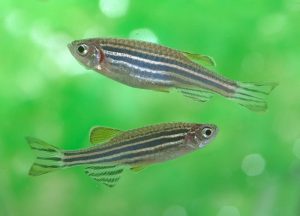18 K-2 Lesson Example
Instructional Guide
Learn about zebrafish embryos and how their anatomy is similar to humans.
Intended Grade Level
K-2 Grade
Students should be familiar with fish. Students should be able to write simple sentences. Students will need to be familiar with using a scientific journal.
Optional: Minnesota State Standards or NGSS:
NGSS
LS1.A: Structure and Function ▪ All organisms have external parts. Different animals use their body parts in different ways to see, hear, grasp objects, protect themselves, move from place to place, and seek, find, and take in food, water and air. Plants also have different parts (roots, stems, leaves, flowers, fruits) that help them survive and grow. (1-LS1-1)
Learning objectives:
Students will be able to describe embryo anatomy.
Students will be able to compare and contrast zebrafish and human anatomy.
Lesson Format:
This lesson will take about 45 minutes. This lesson will involve whole class mini lectures and then break out into small group work. The lesson will involve live fish and embryos, plus having volunteers in the room will be helpful. Students will each need a copy of the science journal.
As a whole class students will learn about zebrafish embryos, and follow along in their science notebook. (10 minutes)
Next, students will observe adult zebrafish and draw a zebrafish in their science journal. (10 minutes)
After, students will observe zebrafish embryos and write in their science journal. (10 minutes)
At the end of the lesson there will be a whole class wrap up discussion and an opportunity to answer any remaining questions (10 minutes).
Lesson Background:
Zebrafish (Danio rerio) embryos are a widely used model organism in developmental biology due to their transparent bodies and rapid development. They provide valuable insights into vertebrate development and genetics. Here’s a breakdown of key anatomical structures in zebrafish embryos:
- Chorion: The chorion is the outermost protective membrane that surrounds the zebrafish embryo. It is a translucent, acellular layer that serves as a barrier, protecting the developing embryo from mechanical stress, pathogens, and harmful substances. The chorion typically remains intact until hatching, which occurs around 48–72 hours post-fertilization when the embryo breaks through using its hatching gland enzymes.
- Yolk: The yolk is the large, nutrient-rich structure that sustains the embryo during early development. It contains proteins, lipids, and other nutrients necessary for growth. In zebrafish, the yolk is prominent and located at the ventral side of the embryo, contributing to nourishment until the embryo develops a mouth and begins feeding independently. The yolk gradually diminishes as the embryo metabolizes it for energy.
- Heart: The zebrafish heart is one of the earliest organs to develop. It begins beating around 24 hours post-fertilization. The heart is initially a simple tube that later undergoes morphogenesis to form a two-chambered structure (an atrium and a ventricle). Studying heart development in zebrafish embryos is particularly valuable due to the similarities with human cardiovascular development.
- Otolith: Otoliths are small, calcium carbonate crystals located in the inner ear of zebrafish embryos. They play a crucial role in the sense of balance and spatial orientation. The otoliths help the developing embryo detect gravity and motion, functioning as a part of the vestibular system, which is essential for the zebrafish’s ability to orient itself in water.
These structures highlight the intricate processes of zebrafish embryogenesis, making the species an important model for studying developmental biology and disease.
Activities:
Draw on the white board a zebrafish embryo, explaining to students the different anatomy parts and what they do.
Next have students observe adult zebrafish, and draw those in their lab notebook. Ask students what they observe and write key anatomy terms on the board for them to copy into their notebooks as they label the fish (ie. “fins” “mouth” “scales” “eyes”)
Then, students will observe zebrafish embryos and draw those in their lab notebooks. Ask students to label this drawing with the following terms: Eyes, heart, yolk, chorion, otolith.
Lastly, discuss as a class what anatomy humans have that is the same as the zebrafish (heart, eyes, mouth). What are differences? (yolk vs stomach, otolith vs ear, scales vs skin) Have students fill out the venn diagram while you model on the white board.
Common misconceptions and challenge points:
Students may struggle to spell words, it can be useful to have them on the board written out, or having a word bank included in the science journal.
Students may struggle with identifying analogous body parts, you can help by starting with an example. “Zebrafish embryos have a yolk to get all their nutrients so they can grow bigger. Where do you get your nutrients?”
Assessment:
Completed lab notebooks will help identify if students are able to label different body parts correctly and are able to compare and contrast human and zebrafish anatomy.
Resources:
Zebrafish embryo drawing


